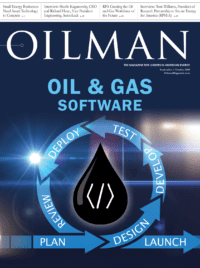One unfortunate aspect of owning a business is that, from time to time, there will be a disagreement with another party — be it a client, employee, contracted partners or an outside organization — that can’t be resolved by any other means but a lawsuit.
In the oil industry, issues surrounding land use factor prominently into lawsuits. For example, disputes commonly arise over contracts for the operation of pipelines or the leasing of land where wells are located. Royalty income is another frequent focus of litigation, as royalty owners battle over the income to which they feel they’re entitled. In addition, oil and gas businesses continue to see a rise in legal matters related to environmental issues.
As different as these civil lawsuits are from one another, the legal process for each one plays out roughly the same. Litigation requires both parties to go through discovery, during which they gather any relevant files to respond to document requests and to support their side of the case. What was once a tedious task of gathering physical documents by hand, has evolved into a fully digital process that sweeps up a wide variety of data much more efficiently.
During electronic discovery (eDiscovery), these disparate forms of data are collected, processed, analyzed, filtered, reviewed and ultimately produced to opposing parties. If you’ve ever started this process from scratch, you know that it can be time-consuming, stressful and — if your company’s data isn’t well managed to begin with — fairly chaotic.
It’s true that for some companies, lawsuits only come around once in a while (if you’re lucky). But when the need for eDiscovery occurs, it doesn’t help anybody to handle it each time in the same haphazard, frantic way. In addition to putting unnecessary stress on your IT department to collect the necessary data, working on an accelerated time frame can result in data being lost or mishandled that might make the difference between winning or losing a case.
All of this can be avoided by taking a step back and thinking about eDiscovery instead as a long-term, standard business process. Assuming that you’ll be involved in one or more lawsuits during the life of your company — and chances are you will — it’s simply a smart business decision to establish a system that allows you to respond to eDiscovery needs more quickly and with the confidence that you have every relevant document available to use in your case.
Here’s how you can start creating a standard eDiscovery process:
1. Take stock of your situation
Taking on a company-wide standardized eDiscovery process may sound overwhelming. Particularly if you have multiple offices or have previously merged with another company, you may not have a good handle on what data even exists and where it’s located.
So, obviously, that’s the first step. In as detailed a way as possible, map out where your organization’s data is – what files are with what people and in what departments, when they were created or modified, and who has access to them. Go beyond what you might think is relevant — in addition to invoices, maintenance records, contracts and land-lease agreements, data including emails, voicemails, photos, videos, Slack messages, social media posts and even texts are all admissible in court.
Also outline your processes for managing litigation holds, the method by which your data will be collected and if you will do any initial filtering of your collected data. However, be cognizant of the time it might take. If you’re adding one or all of these tasks onto your IT department’s already heavy workload, consider whether it’s in your best interest to find a software solution and/or to hire an outside vendor to do the job.
2. Choose an effective eDiscovery platform
To save both time and money in your eDiscovery process, select a platform (or multiple platforms — more about that in a second) that is capable of collecting and processing your data and preparing it for legal review. Look for a comprehensive solution capable of automating legal holds, doing remote collection of targeted groups of data and culling down your files. Ideally, your platform will also provide preliminary data analytics — allowing you to weed out irrelevant documents early in the eDiscovery process, understand the amount of data you’re working with and predict potential costs.
Most companies choose to also use a second, compatible platform for reviewing the files. This platform typically can do more in-depth analysis and search the data to determine relevance. As complex as this might sound, it all saves money in the long run if it prevents your legal team from having to unnecessarily dig through documents at what will certainly be a high hourly rate.
There’s one additional benefit of having a centralized eDiscovery platform, and it’s a huge one — once your documents have been collected, reviewed, tagged and processed as part of a case, they’re there to stay in a safe, centralized place. There’s no need to collect them or have them go through legal review a second time, and they can be used again if future cases call for them.
3. Keep your review costs down with advanced planning
Document review is usually the most expensive part of the eDiscovery process. The most effective way to reduce this cost is to make sure that the data you’re handing over for legal review is pared down as much as possible. One increasingly popular way of doing that is to use TAT (Technology Assisted Review). It’s a form of artificial intelligence that can be taught to identify relevant documents, and the system gets better at its job over time. TAR is a game-changing innovation that can streamline the review process dramatically, reducing costs and maintaining a high level of quality. TAR’s only drawback at the moment is that it hasn’t advanced to the point where it can accurately categorize spreadsheets or files that contain mostly formulas and graphs.
Lastly, once you’ve prepared your data for the review process, you’ll need to decide whether you’ll outsource a legal team, which could include contract attorneys or a full-time managed review services team supplied by an outside vendor. Alternatively, your in-house attorneys could do the work. Although each option has its advantages, your primary concern should be that the team has the background knowledge and training to do their work effectively. Using the same team each time you need documents reviewed will provide institutional knowledge and ensure consistency, quality, accuracy and speed — so whatever you decide, make sure you’re thinking long-term.
Because litigation is almost a fact of life for successful businesses, particularly in the oil industry, it’s smart to be prepared rather than tackling a large, important job under tight time constraints. A standard eDiscovery process goes hand in hand with your company’s information management procedures, it will enable you to respond to any legal issues quickly and effectively, and it will save significant time and money compare to an ad-hoc approach.
Brian Schrader, Esq., is President & CEO of BIA (www.biaprotect.com), a leader in reliable, innovative and cost-effective eDiscovery services. With early career
experience in information management, computer technology and the law, Brian co-founded BIA in 2002 and has since developed the firm’s reputation as an industry pioneer and a trusted partner for corporations and law firms around the world. He can be reached at bschrader@biaprotect.com.







